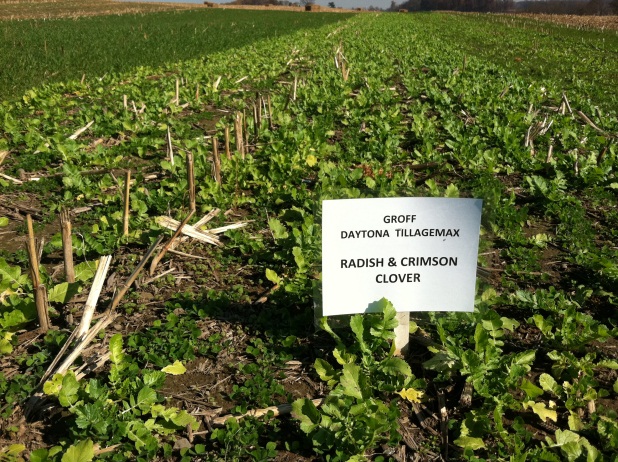A cover crop is any crop grown for the purpose of benefitting the soil and other crops by providing nutrients and preventing erosion. Generally they are not harvested for profit. Growing cover crops over the winter can prevent soil erosion that occurs when soil is left bare. The root growth from some cover crops can help loosen soil and create macropores, improving soil structure. Cover crops can also provide nutrients, such as Nitrogen and Phosphorus, by capturing them and making them available to next year’s crop, reducing your fertilizer needs. Cover crops also help protect groundwater by absorbing excess soil nitrogen which can seep into groundwater; this is especially important if manure is applied in the fall or winter. If no till practices are implemented then the cover crop residues can increase soil organic matter, an essential need for plant growth. They can also be a great alternative to herbicide because they prevent weed growth by blocking light to young weed seedlings.
Types of Cover Crops
Cover crops include grasses, legumes, and other broadleaf species. Common species include barley, oats, hairy vetch, clovers, forage radish, and buckwheat. Winter rye is the most common winter-hardy cover crop used in Pennsylvania. Even if the crop used can’t survive the colder temperatures of winter, if enough growth is achieved in the fall months, benefits will still be achieved.
When to Plant Cover Crops
Cover crops are generally planted after main crops are harvested; during the late summer and early fall. Some recommended seeding deadlines for common crops include: Barley(Oct. 15), Rye and Wheat (Nov 1), and Oats (Sept. 20). Increase seeding rates by 25% if planted later. They need to be planted early enough to have 4-6 inches of growth and 50% cover by winter or soil protection effectiveness will not be maximized.
Some Considerations
Research is continuing to show that use of cover crops can significantly increase the yield of the harvest crop the following year by providing water and nutrients for more successful growth. Most studies show that careful planning and multiple year use is necessary. It can take a couple of years before yields improve because time is needed to develop a “benefit bank” in the soil. The method and timing of both cover crop planting as well as termination in the spring can be important in creating the desired results.
Programs
USDA NRCS
USDA NRCS administers a variety of cost share programs to implement conservation practices such as cover crops. The Conewago is USDA’s “Showcase Watershed” meaning the watershed is targeted for resources and funding.
319 Funding
Farms in priority areas of the watershed may also be eligible for funding through the County Conservation Districts’ 319 funding.
Interested in implementing this practice?
Contact:
Heather Grove, USDA NRCS
(717) 874-2530, heather.grove@pa.usda.gov
Eric Naguski, DCCD
(717) 921-8100, enaguski@dauphinc.org
Web Resources
Suppressing Weeds with Cover Crops-http://pubs.cas.psu.edu/FreePubs/PDFs/uc210.pdf
Cover Crop Selection- http://extension.psu.edu/agronomy-guide/cm/sec10/sec103

